Donations for the purpose of poverty relief achieved the highest share in the total number of donation instances and the donated amount in 2022. Specifically, more than half of donation instances and slightly less than half of the total recorded amount were intended for this purpose. Regarding the value of donations, a high amount was recorded for healthcare. Among other generally less supported causes, seasonal giving stood out in terms of the frequency of support, while a large share of the donated amount was intended for the support of the Kosovo Government’s Security Fund.
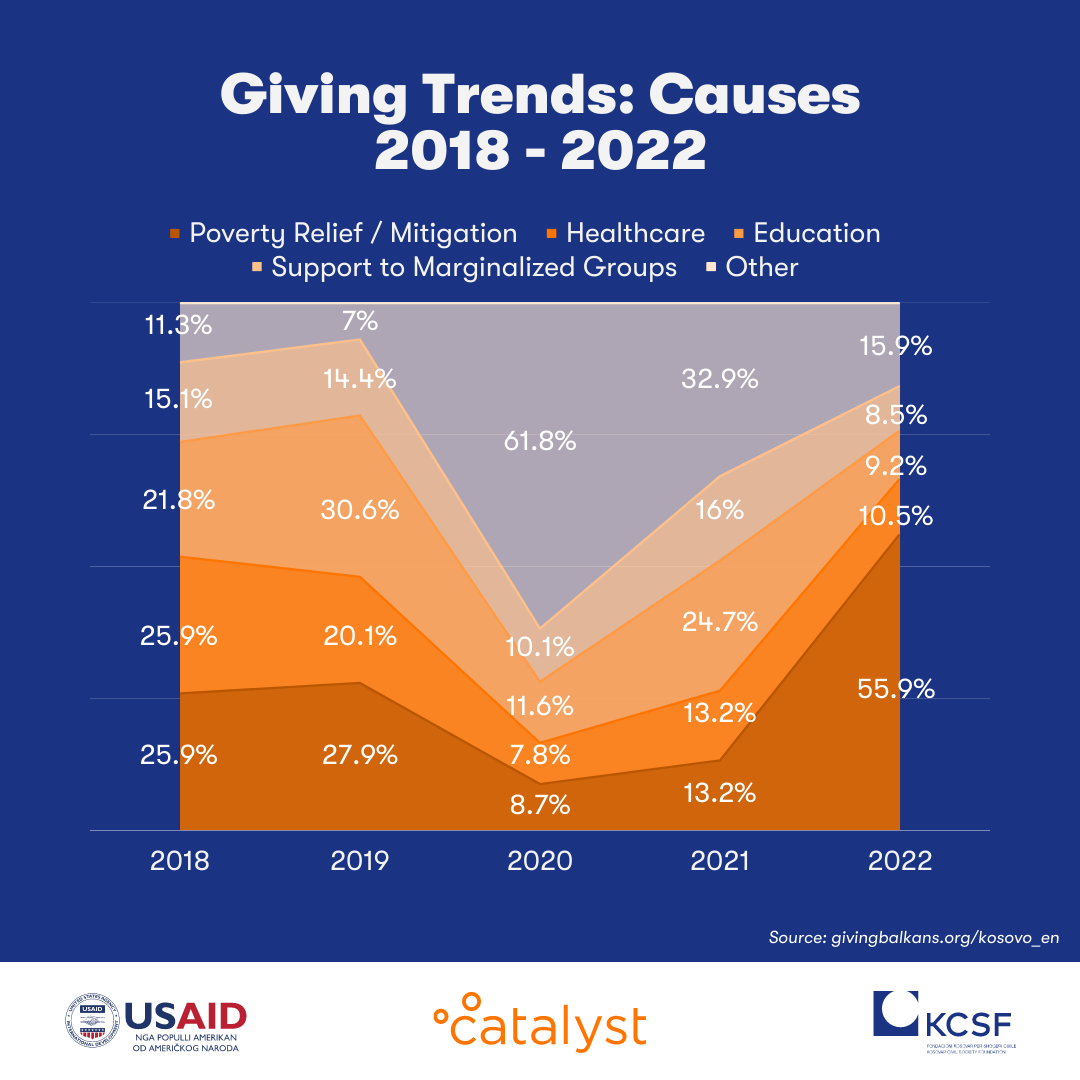
Trends in giving causes 2018 - 2022 - download this infographic in PDF
Poverty relief has been a leading cause that the Kosovo philanthropy ecosystem supported throughout the years, fluctuating between 25.9% and 55.9% of all giving, except the COVID-impacted years of 2020 and 2021.
Giving for healthcare, education, and support to marginalized groups have consistently been additional key causes supported in Kosovo, but their levels have varied over the last eight years.
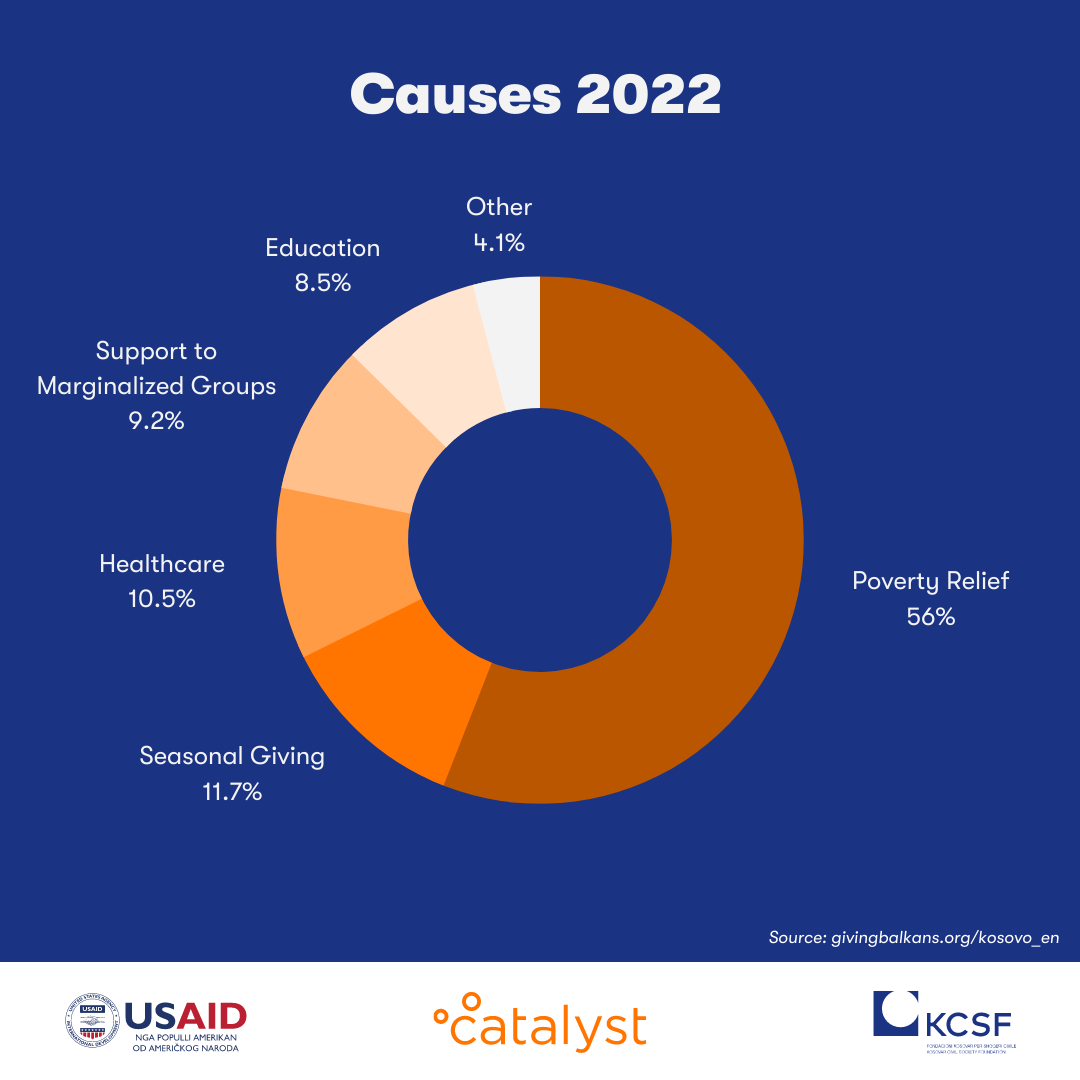
Distribution of giving in Kosovo in 2022 by cause - download this infographic in PDF
A full breakdown of all 2022 giving by cause areas shows the frequency of giving to less supported causes but still a focus of philanthropy. 2.3% of all giving fell under the category of Other and is reflective of the donations made to the Government of Kosovo’s Security Fund. Giving for environmental protection and mitigation totaled 0.7% of the 2022 levels, followed by Culture and Arts (0.4%) and Religious Activities (0.2%). Heritage, Economic Development, and Social Entrepreneurship were supported with 0.1% of giving recorded in Kosovo. Continued giving for remediating the impacts of COVID-19 also amounted to 0.1% of donations.
Causes by Types of Donors
Citizens through mass-individual giving were the most frequent donor type in donations aimed at poverty relief, healthcare, and seasonal giving, while known individuals were the prevalent donor type for the support of education. The corporate sector, domestic associations, and identifiable individuals shared a similar percentage of donations to support marginalized groups.
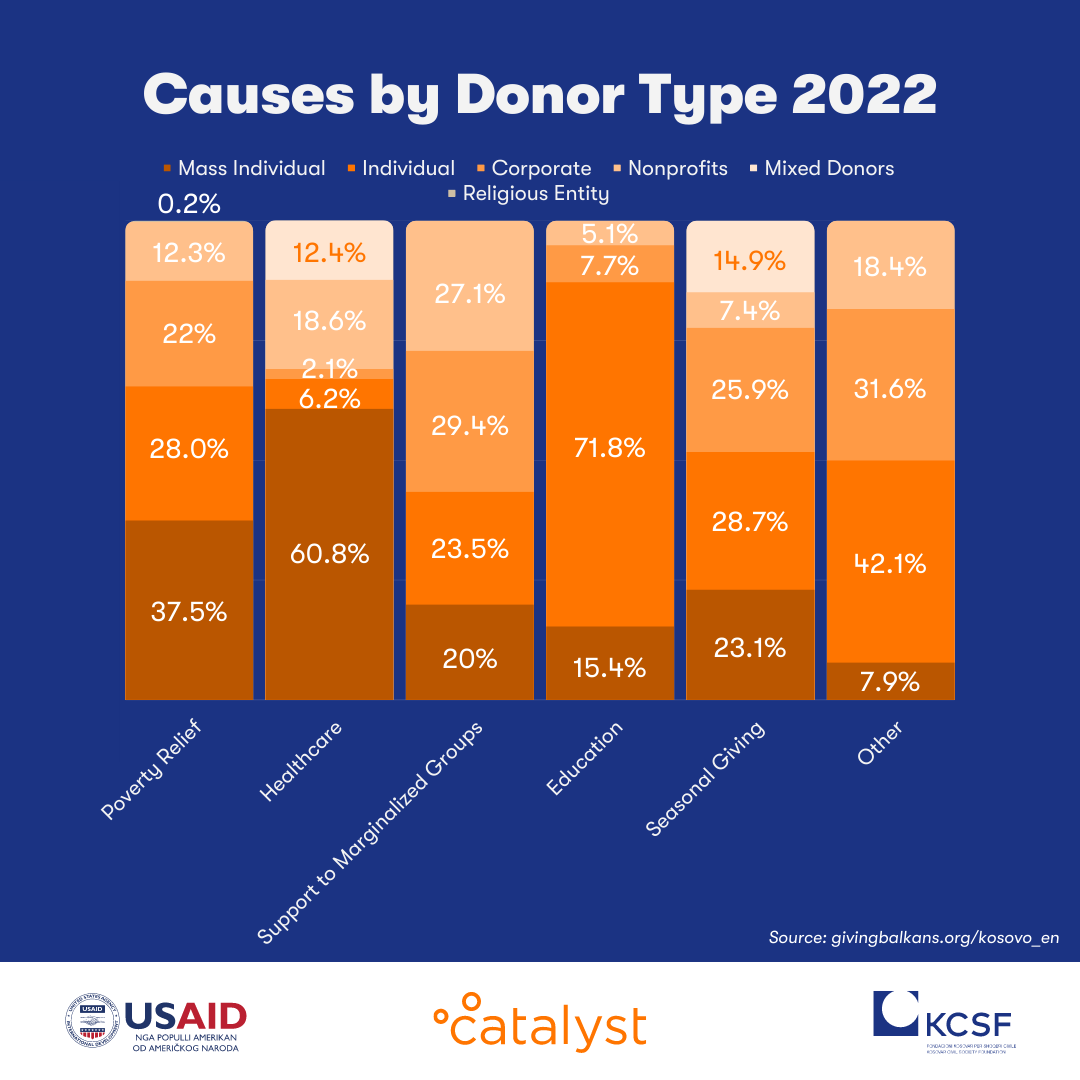
Causes by donor type in 2022 - download this infographic in PDF
Causes by Intended Effects of Giving
Giving to achieve short-term results was the prevalent form across the key cause areas in 2022. For example, 40.7% of giving for poverty relief was in the form of humanitarian support (food and other consumables).
Strategic support was predominant in the area of education, with scholarships and stipends for students being the most frequent form of donations.
All seasonal giving was intended for achieving short-term results, which corresponds to the nature of seasonal giving as being driven by various religious holidays and the tendency of faith-driven donations to be aimed at humanitarian support.
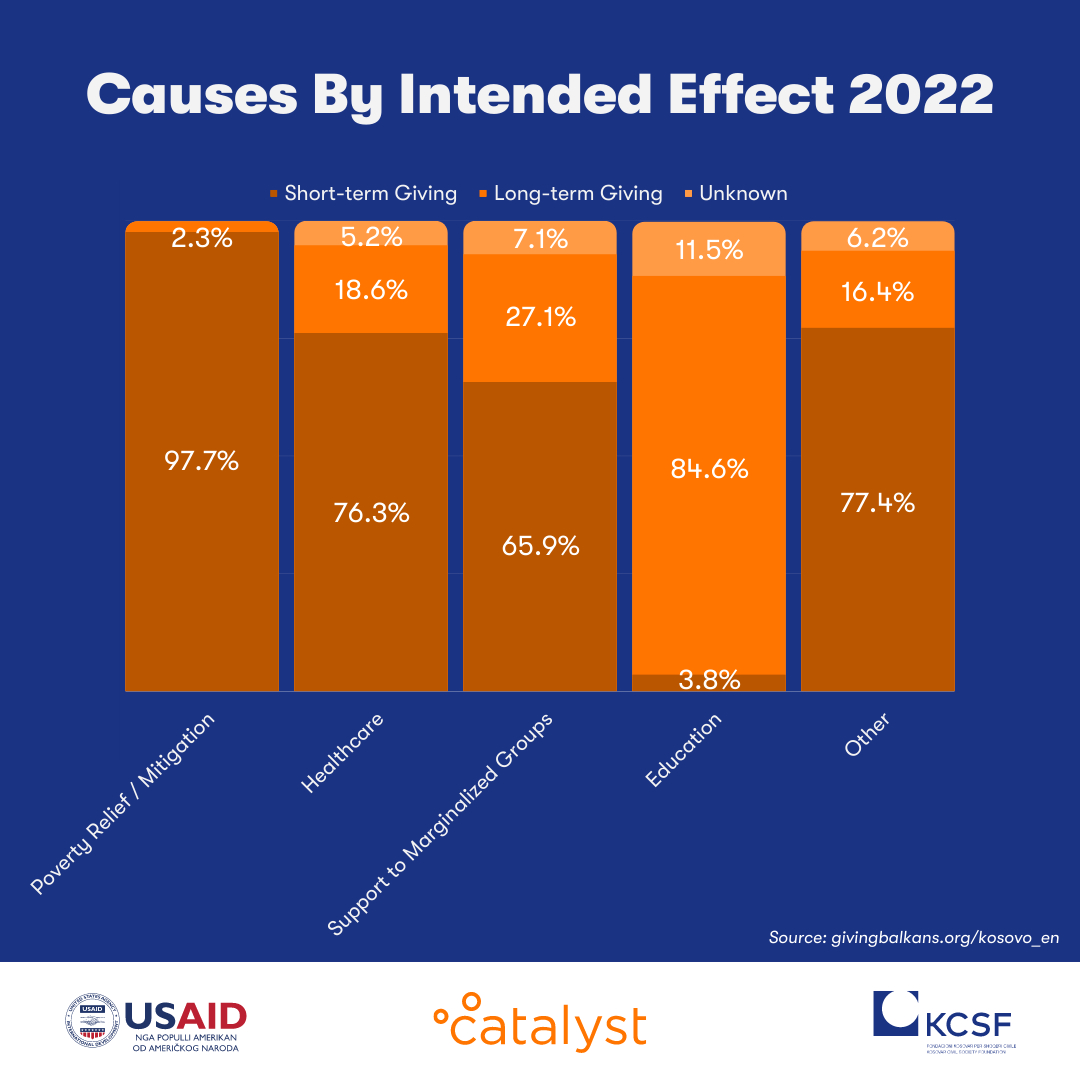
Causes by intended effects in 2022 - download this infographic in PDF
Examples of Giving
“Sofra e Ramazanit 2022” (“Ramadan Table”)
The Bereqeti Association, in cooperation with the Islamic Community of Kosovo, organized the traditional humanitarian campaign “Sofra e Ramazanit 2022” (“Ramadan Table”) during the month of Ramadan. The action aimed to provide food packages to socially disadvantaged families in all municipalities across Kosovo. Several corporate donors, including the supermarket Lindi Center, Diamanti, Meka Halal Food, and AB Bajrami gave their cash or in-kind support along with numerous local and diaspora individual donors. More than EUR 45,000 was raised for this campaign.
“Ec Me Këpucët e Mia” (“Walk In My Shoes”)
A solidarity march was held on World Down’s Syndrome Day (21 March) under the motto “Ec Me Këpucët e Mia” (“Walk In My Shoes”). Citizens supported the action by joining the march to raise public awareness of the needs of people with Down’s Syndrome. The Down Syndrome Kosovo Association organized the action as part of the campaign “Një Kartolinë për Ty” (“A Postcard For You”). During the campaign, stalls with postcards made by association members were placed in the Zahir Pajaziti Square in Pristina and other squares in cities throughout Kosovo. Various donors contributed to the campaign by donating directly and through the symbolic purchases of the postcards. By the end of the campaign, EUR 38,600 was raised across the four centers of Down Syndrome Kosova – in Pristina, Ferizaj, Mitrovicë, and Prizren.
Actions of the KEDS and Twig
Celebrating World Earth Day (22 April), the company KEDS donated twenty seedlings and organized their planting on the hill by the Faculty of Electrical and Computer Engineering (FIEK). Students of the faculty and students of the KEDS Academy planted the seedlings. Professor Avni Alidemaj initiated the action from KEDS.
In a similar action, the company Twig contributed to greening the Municipality of Mitrovicë by donating 27 seedlings. Representatives of the company, the Directorate for Environmental Protection, and volunteers helped plant the seedlings near Mitrovicë Lake.
More on the state of philanthropy in Kosovo in 2022:
- Giving Kosovo 2022: Report on the State of Philanthropy
- Infographic: What Causes Kosovar Citizens and Companies Support?
- Shifts in Kosovo's Philanthropy: Recipient Trends and Giving Flows in 2022
- Kosovo Philanthropy: Beneficiary Groups and Support Channels in 2022
- Kosovo's 2022 Donor Landscape: A Deep Dive into Individual, Corporate, and Diaspora Giving
- Understanding the Intended Effects of Philanthropic Giving in Kosovo: Short-Term vs. Long-Term in 2022
This report is made possible by the generous support of the American people through the United States Agency for International Development (USAID). The contents are the responsibility of Catalyst Balkans and do not necessarily reflect the views of USAID or the United States Government.
The Citizen Engagement Activity in Kosovo is a five-year initiative implemented by Kosovar Civil Society Foundation (KCSF) in partnership with the United States Agency for International Development (USAID).
Cover photo: unsplash.com
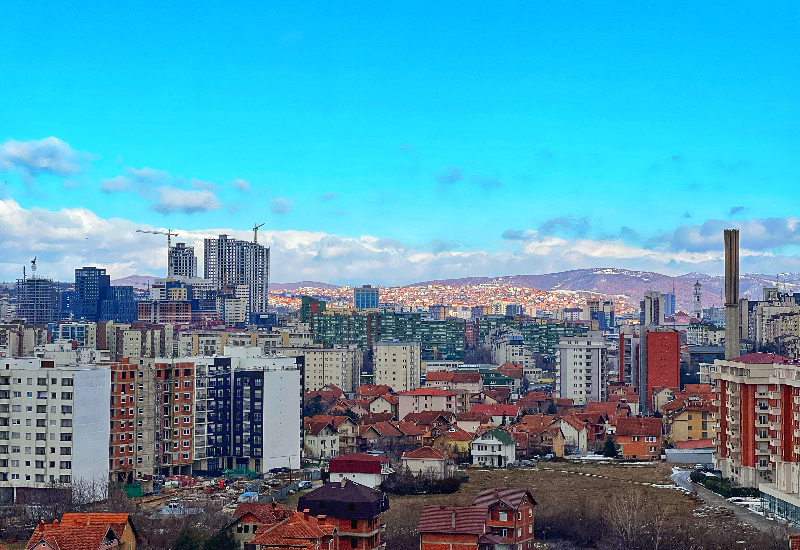

Leave a comment